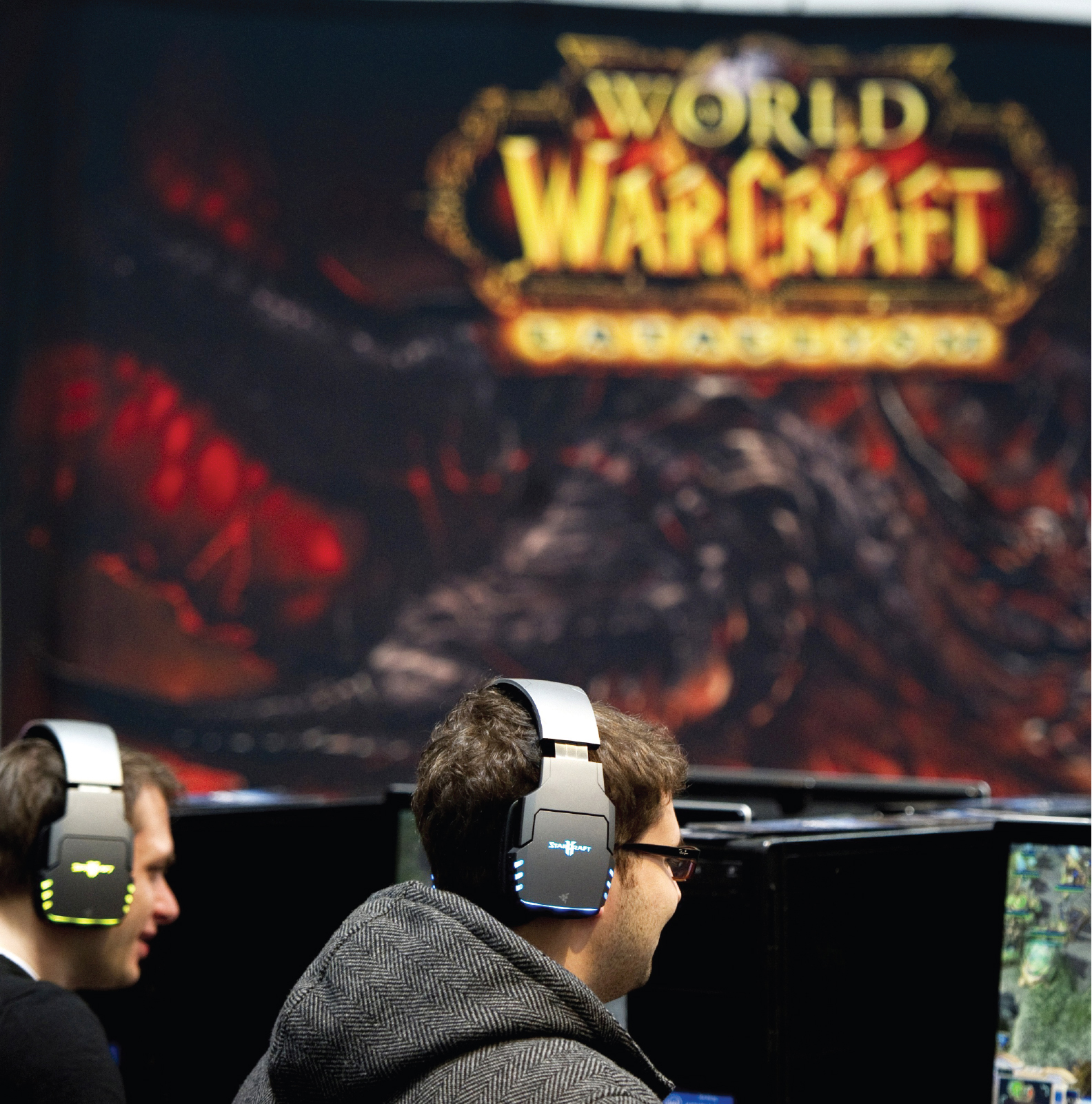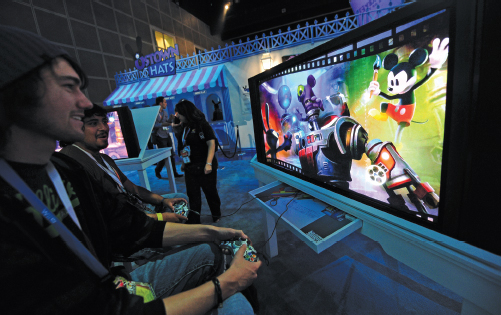Introduction
| 3 |
| Digital Gaming and the Media Playground |
“In the outside world, I am a simple geologist. But in here, I am Falcorn, defender of the Alliance. I’ve braved the Fargodeep Mine, and defeated the Blood Fish at Jerod’s Landing.”
RANDY MARSH, SOUTH PARK, “MAKE LOVE, NOT WARCRAFT,” 2006

In October 2011, producers released the trailer film for the latest blockbuster sequel coming to screens around the world. As the trailer revealed, the next installation of the series featured new special effects and more pitched battles between the Alliance and the Horde on the planet Azeroth. Critics wrote positive advance reviews, and with young target audiences and a big distribution push planned for Asia, it had the makings of another Hollywood blockbuster.
Except that the sequel wasn’t a film—it was an expansion of World of Warcraft (WoW), the most successful massively multiplayer online role-playing game (MMORPG), with more than ten million players worldwide. The fantastical setting of Azeroth was first introduced in the strategy game Warcraft: Orcs and Humans, released on CD-ROM in 1994 by Blizzard Entertainment. But it wasn’t until 2004 with the release of World of Warcraft that the playing environment became completely immersive and online, enabling millions of players from around the world to participate.
Since then, World of Warcraft and its culture have spread beyond the gaming community to become a part of the mainstream. Not only did WoW spawn a parody episode of South Park (“Make Love, Not Warcraft”), there is a film in the works. And the famous “Leeroy Jenkins” video that captures the breakdown in communication among a group of WoW players on a dangerous dungeon raid has garnered more than thirty-six million views on YouTube.
The beginner’s guide for World of Warcraft reads something like the narrative of an epic novel, describing the “two large, opposing factions. On one side is the noble Alliance, which comprises the valiant humans, the stalwart dwarves, the ingenious gnomes, the spiritual night elves, the mystical draenei, and the bestial worgen[ ; ] … on the other side is the mighty Horde, made up of the battle-hardened orcs, the cunning trolls, the hulking tauren, the cursed Forsaken, the extravagant blood elves, and the devious goblins. Your character’s race will determine whose side you are on, so choose carefully.” 1
Since the original game, there have been four expansions: The Burning Crusade (2007), the Wrath of the Lich King (2008), Cataclysm (2010), and Mists of Pandaria (2012). Each expansion opens up new continents on Azeroth for exploration, introduces new characters, and adds new play features. For example, the Cataclysm expansion brought more than thirty-five hundred new quests, enabling players to have an enormous range of playing possibilities and ways to unfold the experience of the narrative.
“Print has been around for 570 years, cinema for 120, television for 80. Yet in just four decades, the video-game industry has beaten them all, becoming the most profitable—and, arguably, the most dynamic and innovative—entertainment medium on the planet.”
JAMIE RUSSELL, SUNDAY TIMES (LONDON), 2012
Mists of Pandaria, the latest expansion, is set in “lush forests and cloud-ringed mountains” and is “home to a complex ecosystem of indigenous races and exotic creatures.”2 The Pandarians (who look like pandas and live in a land that appears to be a fantasy version of ancient China) have been at peace for ten thousand years, now disrupted by the arrival of the Alliance and the Horde. Pandarians are a “playable” race, and gamers can ally their Pandarian avatar with either the Alliance or the Horde. Mists of Pandaria feels like a movie in many ways, with its cinematic music, sound effects, expansive vistas, and grand stories. But there are also ninety levels of play in which players use the unique powers of their characters to complete quests, creating their own “narratives.” Playing World of Warcraft is a social experience as well, as players chat and form “guilds” with others for the more difficult quests. World of Warcraft costs $14.99 per month to play (less for multiple-month rates). What players get is not only the experience of the game’s rich narratives—just like watching a movie—but also the ability to create their own narratives by themselves and with fellow players.
The next step for World of Warcraft and other immersive digital games? Virtual reality headsets, a technology that already exists but has yet to be mass-produced inexpensively. When that time comes, players’ perceptions will move from in front of a monitor to into the game.
ELECTRONIC GAMES OFFER PLAY, ENTERTAINMENT, AND SOCIAL INTERACTION. Like the Internet, they combine text, audio, and moving images. But they go even further than the Internet by enabling players to interact with aspects of the medium in the context of the game—from deciding when an onscreen character jumps or punches to controlling the direction of the “story” in World of Warcraft. This interactive quality creates an experience so compelling that vibrant communities of fans have cropped up around the globe. And the games have powerfully shaped the everyday lives of millions of people. Indeed, for players around the world, digital gaming has become a social medium as compelling and distracting as other social media. The U.S. Supreme Court has even granted digital gaming First Amendment freedom of speech rights, ensuring its place as a mass medium.
In this chapter, we take a look at the evolving mass medium of digital gaming and:
- Examine the early history of electronic gaming, including its roots in penny arcades
- Trace the evolution of electronic gaming from arcades and bars into living rooms and our hands
- Discuss gaming as a social medium that forms communities of play
- Analyze the economics of gaming, including the industry’s major players and various revenue streams
- Raise questions about the role of digital gaming in our democratic society

Past-Present-Future: Digital Gaming
Playing games is part of being human. As we discuss later in this chapter, the business of playing games is a more modern pursuit, designed to take advantage of our leisure time. The rise of amusement parks in the late 1800s, with rides and carnival games, brought people together to enjoy created experiences. Later, mechanical and electronic games brought those experiences into year-round use at bars, arcades, and homes.
Today’s gaming environment has gone digital—on a console, on a computer, on a mobile device—and as a result become more popular than ever. Mirroring our lives in which work can be done everywhere (at home or out, on our computers, or on our mobile devices), games are everywhere, too, offering a few minutes of downtime with a casual game like Fruit Ninja or complete release with an immersive experience like Dark Souls. The ubiquity and wide price range of digital games mean that the “gamer” demographic has also broadened to include males and females, of every age and race, in every location.
Our current experience with video games hints at their future. On one hand, games will become more and more realistic and immersive, reading our body movement (as the Wii or the Kinect do now), our facial expressions, and our thoughts, and inserting us into even more highly developed fantasy worlds. (Think of the movie Avatar.) On the other hand, games will become even more enmeshed with everyday life, as motivating forces in our workplaces, schools, media, and social lives.